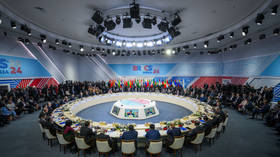BRICS to outpace G7 in global exports share – report

The BRICS group could overtake the G7 countries in terms of its share of global merchandise exports by 2026, Ernst and Young India has projected.
According to a report issued on Wednesday, BRICS nations’ combined share of global merchandise exports rose from 10.7% in 2000 to 23.3% last year.
In contrast, the G7 share has declined from 45.1% to 28.9%. The share of the rest of the world in global merchandise exports has increased slightly from 44.2% to 47.9% during the same period.
The report highlighted that the highest share in global exports by BRICS in 2022 was textiles at 49.6%, followed by telecommunications equipment at 41.3%, clothing at 36%, electronic data processing and office equipment at 35.7%, and fuels at 30.3%.
It also noted a substantial increase, from 5.0% in 2000 to 32.8% in 2022, in the share of high technology exports from BRICS nations. These comprise electronic data processing and office equipment, telecommunications equipment, and integrated circuits and electronic components. The development reflects the group’s shift towards high technology-intensive products, EY said.
In terms of imports by BRICS nations, their aggregate share of all commodities is lower than their share of exports, the report showed, meaning the BRICS group is a net exporter to the rest of the world.
“The importance of BRICS+ group of countries has progressively increased in terms of size of economy, and their respective shares in global exports and imports of goods,” EY wrote. “The BRICS+ group is likely both to compete and co-operate with the G7 group for determining world economic and trade policies,” it added.
The report said that coordinated BRICS policies could eventually lead to a reduction in the dominance of the US dollar as the currency of choice for global trade and foreign exchange reserves, as well as in the use of the SWIFT, and the subsequent decline of Western economies in technological leadership.
“The lead of G7 in managing global economic affairs is likely to come into question as the share of the BRICS+ group in global population, world GDP and world trade increases,” EY concluded.
The report also noted, citing data by the IMF and the WTO, that the BRICS countries’ contribution to global growth in terms of PPP is on the rise, currently amounting to 36.7%.
The global GDP share of the G7 countries (Canada, France, Japan, Italy, the US, UK, and EU) in terms of PPP has dropped from 50.42% in 1982 to 29% in 2024. PPP compares economic productivity and living standards between countries by adjusting for differences in the cost of goods and services.
BRICS was initially founded in 2006 by Brazil, Russia, India, and China, with South Africa joining the group in 2010. This year, four more countries officially joined the bloc: Egypt, Iran, Ethiopia, and the United Arab Emirates. Saudi Arabia, which was also invited to become a member, also participates in BRICS events but has not finalized the ratification process.













